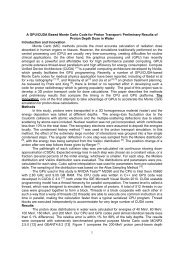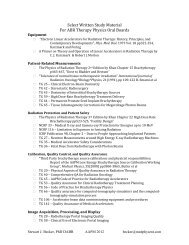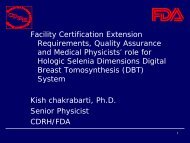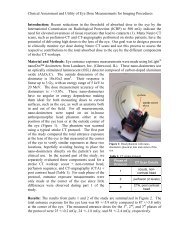SBRT&StereoscopicIGRT_2012 [Compatibility Mode]
SBRT&StereoscopicIGRT_2012 [Compatibility Mode]
SBRT&StereoscopicIGRT_2012 [Compatibility Mode]
Create successful ePaper yourself
Turn your PDF publications into a flip-book with our unique Google optimized e-Paper software.
IGRT and SBRT Programs with<br />
Siemens Accelerators and ExacTrac<br />
ExacTrac<br />
Stereoscopic XX-ray<br />
XX-ray<br />
ray System<br />
System<br />
Dimitris Mihailidis Mihailidis, , Ph.D.<br />
Charleston Radiation Therapy, Charleston, West Virginia<br />
QUESTION:<br />
Can Stereoscopic x-Ray IG Technology convert a<br />
conventional Siemens (Primus or Oncor) linac into<br />
a “precision” IG - SBRT delivery machine ?<br />
Description of the Systems<br />
BrainLab ExacTrac System:<br />
Two X-ray tubes.<br />
Two amorphous silicon detectors (20x20 cm 2 ).<br />
Infrared Polaris system.<br />
Touch screen and arm.<br />
512x512 Matrix<br />
X-Ray phantom.<br />
ISO phantom.<br />
Rando pelvis phantom.<br />
Reference star or markers.<br />
Linear Accelerators with features<br />
specifically suitable for SBRT<br />
* Slide courtesy of Brian Kavanagh / University of Colorado<br />
Introduction and Purpose<br />
Implement Image Guidance (IG) on a<br />
Siemens Linac (Primus or Oncor).<br />
Necessary components to include for IG<br />
upgrade.<br />
<strong>Compatibility</strong> of components to provide an<br />
IG solution.<br />
Transition to an SBRT program.<br />
Siemens PRIMUS with ExacTrac System<br />
In-room monitor<br />
Infrared camera<br />
Imaging<br />
panels<br />
X-ray tube<br />
1
Siemens linac preparation<br />
Gantry rotation – radiation isocenter<br />
X-Jaws 1.02 mm<br />
Y-Jaws 0.06 mm<br />
TG-142 requirements for IMRT & SBRT:<br />
Mechanical and radiation isocenter verification:<br />
Gantry rotation (
Scan direction<br />
MLC picket fence test for Siemens<br />
center-to-center<br />
2 cm<br />
The Technology at CRTC for SBRT<br />
• Siemens Primus and Oncor Linacs.<br />
Scan direction<br />
• Philips large bore CT simulator (4D-CT capability).<br />
• Philips Pinnacle 3 Treatment Planning System.<br />
• BrainLab ExacTrac 6D-Stereoscopic X-ray Image<br />
Guidance System.<br />
Planning System Commissioning<br />
Philips Pinnacle Pinnacle3 v8.0m with with DMPO in in<br />
step step-and and-shoot shoot mode.<br />
Have strong<br />
and<br />
frequent engineering support !<br />
Move on with SBRT<br />
Utilize more accurate patient immobilization<br />
devices.<br />
Utilized 4D-CT simulation for appropriate sites<br />
(e.g., lung, liver, etc), ITV approach.<br />
Utilized highly conformal multi-beam treatment<br />
planning and intensity modulation.<br />
Utilized image guidance for patient daily setup.<br />
Utilized on-line patient surveillance and setup<br />
correction during treatment.<br />
Utilized 5 and 10 mm MLC width for delivery.<br />
Small field size measurements<br />
<strong>Mode</strong>l fit to the data<br />
BEAM MODEL<br />
3
DMPO<br />
1.00<br />
0.90<br />
0.80<br />
0.70<br />
0.60<br />
0.50<br />
Small field size measurements<br />
OUTPUT FACTORS<br />
0.1cc Scanning IC<br />
Diode Perp. (norm to 5x5)<br />
Microchamber<br />
XV Film<br />
Small fields-MLC shaped<br />
Pinnacle Hi Res<br />
Pinnacle Lo Res<br />
0.40<br />
0.00 0.50 1.00 1.50 2.00 2.50 3.00 3.50 4.00 4.50 5.00<br />
Direct irect Machine achine Parameter arameter Optimization ptimization<br />
• DMPO produces final segments at the end of the<br />
optimization process. NO conversion is required.<br />
Automatically converts the ODM to MLC control<br />
points.<br />
• The MLC leaf positions and the weights of the<br />
segments are optimized at once (equivalent to DAO).<br />
• The time to prepare a plan is substantially reduced in<br />
DMPO.<br />
• You can filter the final control points according to<br />
area and monitor units.<br />
Dosimetric Comparison of MLC systems<br />
Linac MLC system MLC width<br />
Siemens Primus (X-jaws) Optifocus double-focused (divergent) - 58 leaves 10 mm<br />
Siemens Oncor (X-jaws) Double-focused (divergent)- 82 leaves 10 mm<br />
Siemens Artiste (X-jaws) 160MLC (rounded) - 160 leaves 5 mm<br />
Varian Trilogy (tertiary) Millennium (rounded) - 120 leaves 5 mm<br />
Elekta Synergy-S BM Beam Modulator (rounded) - 80 leaves 4 mm<br />
Elekta Synergy Elekta MLC (rounded) - 80 leaves 10 mm<br />
Novalis TX (tertiary) HD micro-MLC – 120 leaves 2.5 mm<br />
Detectors for small field measurements<br />
How important is the MLC system in<br />
multi multi-beam beam SBRT treatment planning?<br />
Method of comparison<br />
“RING”: A special ring-structure around the TV, 1 cm expansion of<br />
the TV – to evaluate the sparing of normal structures adjacent to TV.<br />
________________________________________________________________<br />
CONFORMITY INDEX:<br />
TV = target volume<br />
PIV = prescription isodose volume<br />
PVTV = is the TV included in PIV<br />
Paddick, J. Neurosurg. (Suppl. 3) 93:219-222, 2000<br />
CI = ( PIV / PVTV ) / ( PVTV / TV )<br />
CI = 1, perfect conformity<br />
Nakamura JL, et al., Int. J. Radiat. Oncol. Biol.<br />
Phys. 51, 1313-1319 (2001).<br />
The IL was chosen according to the criteria:<br />
(1) being the greatest IL that covers 95% of TV while<br />
(2) delivering ≥95% of the prescription dose to 99% of the TV.<br />
4
CI<br />
Comparison: Conformity Index<br />
2.5<br />
2<br />
1.5<br />
1<br />
0.5<br />
0<br />
Conformity Index (CI)<br />
4.64 (Lung-3D) 4.64(Lung-IM) 7.63(Brain-IM) 9.85(Lung-3D) 25.78(Spine-IM)<br />
Target Volume (cc)<br />
3D-CRT vs. Intensity Modulation<br />
Mihailidis, et al., AAPM 2009, Med. Phys. 36, (2009) 2660<br />
Oncor (10mm)<br />
Artiste (5mm)<br />
Varian (5mm)<br />
NovalisTX (2.5mm)<br />
Synergy (10mm)<br />
SynergyBM (4mm)<br />
Comparison: MLC systems<br />
Mihailidis, et al., AAPM 2009, Med. Phys. 36, (2009) 2660<br />
LUNG: 3D CRT<br />
Oncor: 10 mm Novalis TX: 2.5 mm<br />
4500 cGy<br />
3600 cGy<br />
Conclusions of comparisons<br />
4275 cGy<br />
Our study is the first to include the majority of today’s MLC<br />
systems in a comprehensive way and has shown no apparent<br />
indication that smaller MLCs can lead to optimal plans, if<br />
multi-field techniques (IMRT or 3D) are utilized in SBRT.<br />
However, we believe that small tumor volumes would benefit<br />
from small MLC widths and single fraction SRS, instead.<br />
Tanyi, JA, Radiation Oncology 4:22 (2009)<br />
5mm Varian<br />
2.5mm Novalis TX<br />
Mihailidis, et al., AAPM 2009, Med. Phys. 36, (2009) 2660<br />
Comparisons: 3D conformal vs. Intensity Modulation<br />
V olum e (% )<br />
120<br />
100<br />
80<br />
60<br />
40<br />
20<br />
0<br />
Peri-tunoral Ring Volume<br />
4.64 cc Lung target<br />
50%(IM) 80%(IM) 90%(IM) 50%(3D) 80%(3D) 90%(3D)<br />
Isodose line<br />
Oncor (10mm)<br />
Artiste (5mm)<br />
Varian (5mm)<br />
NovalisTX (2.5mm)<br />
Synergy (10mm)<br />
SynergyBM (4mm)<br />
Mihailidis, et al., AAPM 2009, Med. Phys. 36, (2009) 2660<br />
Comparison: Lung IMRT- IMRT all MLC systems<br />
10mm<br />
5mm 2.5mm<br />
10mm 5mm<br />
4mm<br />
Mihailidis, et al., AAPM 2009, Med. Phys. 36, (2009) 2660<br />
SBRT – LUNG<br />
NO – GATING!<br />
WHY ?<br />
100% Rx<br />
90% Rx<br />
80% Rx<br />
50% Rx<br />
5
Patient Immobilization<br />
With arms over the head.<br />
Flat lung board with T-bar holder for the arms.<br />
Vacuum Bag<br />
Maximum Intensity Projection (MIP)<br />
CT data is acquired using a Bellows or RPM<br />
device that records a breathing wave.<br />
Maximum intensity values are assigned to pixels<br />
at locations where a tumor moves to over time.<br />
Are a derived dataset of images that show a<br />
“composite” of the tumor volume over the time<br />
period that the CT data was acquired.<br />
4D CT Simulation for LUNG SBRT<br />
CT Scanning procedure for moving target<br />
One free breathing scan – 3 mm slices, entire chest.<br />
One shorter, time-correlated scan – 3 mm slices, to<br />
include the tumor area.<br />
Breathing Waveform is acquired along with CT data<br />
using a Bellows or RPM device.<br />
The CT data acquired in one breath can be binned into<br />
10 equally spaced intervals along the waveform and<br />
reconstructed.<br />
The 10 intervals are called Phases.<br />
Moving Target virtual simulation - Fusion<br />
GTV<br />
MIP dataset<br />
Volume propagation from MIP dataset<br />
to<br />
free breathing dataset<br />
ITV<br />
Free Breathing<br />
dataset<br />
6
Treatment planning<br />
DMPO - optimization<br />
SBRT - LUNG<br />
Patient setup verification<br />
prior to treatment<br />
IMAGE GUIDANCE<br />
Multiple non-coplanar beams<br />
PTV=ITV + 5mm margin<br />
www.charlestonradiation.com<br />
WE HAVE NOTICED:<br />
2-3 segments allow for<br />
dose compensation due<br />
to lack of resolution of<br />
the 10mm leaf width.<br />
Mihailidis, et al., AAPM<br />
2009, Med. Phys. 36,<br />
(2009) 2660<br />
Allow for low low-level level Intensity Modulation<br />
Treatment Isocenter<br />
DVH results<br />
Step-and-shoot mode:<br />
• 2-3 segments per beam.<br />
• 50Gy in 5 fxs.<br />
• Optimization objectives<br />
-heart<br />
-ribs<br />
-normal tissues<br />
Mihailidis, et al., AAPM<br />
2009, Med. Phys. 36,<br />
(2009) 2660<br />
Ipsilateral lung<br />
ExacTrac setup for lung SBRT<br />
Virtual isocenter for IG<br />
ITV<br />
PTV 50Gy<br />
www.charlestonradiation.com<br />
ET reconstructed views<br />
7
ET x-ray<br />
DRR<br />
Before Fusion - misalignment<br />
After fusion – shifts to be implemented<br />
Match of x-ray and DRR<br />
SHIFTS<br />
Patient setup and immobilization<br />
ExacTrac IR markers<br />
www.charlestonradiation.com<br />
Excluded from fusion area<br />
Fusion preparation<br />
SBRT - Brain<br />
Fusion MRI – TP CT<br />
TP CT MRI<br />
Vargo J, Plants B, Welch C, Mihailidis D, et al., ASTRO 2010, IJROBP 78 (No. 3 Suppl), S279 (2010)<br />
8
SBRT brain positioning and planning<br />
Multiple non-coplanar beams<br />
Vargo J, Plants B, Welch C, Mihailidis D, et al., ASTRO 2010, IJROBP 78 (No. 3 Suppl), S279 (2010)<br />
DRR<br />
x-ray<br />
DRR<br />
SBRT - BRAIN<br />
Patient setup verification<br />
prior to treatment<br />
IMAGE GUIDANCE<br />
Fusion<br />
x-ray AFTER<br />
SHIFTS<br />
BEFORE<br />
www.charlestonradiation.com<br />
Prescription:<br />
40 Gy in 5 fxs<br />
788 MU<br />
Sample isodose and DVH<br />
PTV<br />
Vargo J, Plants B, Welch C, Mihailidis D, et al., ASTRO 2010, IJROBP 78 (No. 3 Suppl), S279 (2010)<br />
Patient setup with IR markers<br />
from TPS<br />
IR marker<br />
Continuous IG<br />
objectives<br />
www.charlestonradiation.com<br />
Allow for live patient survaillance with the IR<br />
camera and markers.<br />
Perform a second IG verification between<br />
treatment fields (residual shifts).<br />
Compare reference orthogonal treatment ports<br />
with orthogonal DRRs.<br />
Keep rotations to less than 3° if possible,<br />
otherwise…improvise.<br />
Wood Shims<br />
www.charlestonradiation.com<br />
9
6D-IGRT accuracy: Infrared vs. stereoscopic x-ray<br />
Conclusions<br />
ExacTrac Stereoscopic x-Ray IG system, in<br />
combination with other technologies, provides<br />
accurate IG that allows the implementation of an<br />
SBRT program,<br />
IF<br />
additional precautions are taken.<br />
6D-corrections and residual setup errors<br />
Comply with published recommendations:<br />
10
THANK YOU !<br />
NRAO Green Bank Observatory, West Virginia<br />
http://www.gb.nrao.edu/<br />
11


![SBRT&StereoscopicIGRT_2012 [Compatibility Mode]](https://img.yumpu.com/16889220/1/500x640/sbrtampstereoscopicigrt-2012-compatibility-mode.jpg)













